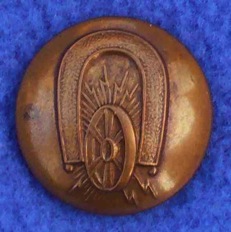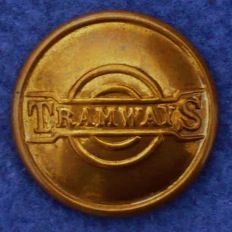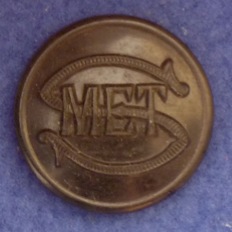South Metropolitan Electric Tramways
Owner South Metropolitan Electric Tramways and Lighting Company Ltd (a subsidiary of the British Electric Traction Company Ltd)
Opened 14th February 1906 (electric)
Operator South Metropolitan Electric Tramways and Lighting Company Ltd
Ownership transferred 14th June 1913 (London and Suburban Traction Company Ltd - a holding company jointly owned by the Underground Electric Railways Company of London Limited and the British Electric Traction Company Limited)
Taken over (operation) 4th November 1926 (London County Council Tramways) - Tooting Junction to Mitcham Cricket Green
Taken over 1st July 1933 (London Transport)
Length 13.36 miles
Gauge 4ft 8½ins
Button description (Pattern 1) Wheel, magnet and electrical flashes
Materials known Brass
Button Line reference [113/16]
Button description (Pattern 2) TRAMWAYS ‘bar and circle’ device within a raised rim.
Materials known Brass
Button Line reference [114/72]
Comment Support for brass Pattern 1 buttons being issued to SMET staff can be found in 'The Tramways of Croydon', G E Baddeley; Light Rail Transport Association (1983), ISBN: 0 900433 90 6.
With respect to the Pattern 2 button, this would appear to have been issued to the 'South Metropolitan Electric Tramways' — along with 'London United Tramways' (LUT) and 'Metropolitan Electric Tramways' — shortly after the end of the Great War. All three tramway companies had effectively been merged — under the umbrella of a holding company (the 'London & Suburban Traction Company Ltd') — over a six-month period between January (LUT and MET) and June 1913 (SMET). Although they continued to maintain their individual identities, from 1915 onwards they were actively administered as a single entity, with some attempts at standardisation (e.g., uniforms) being undertaken.
The 'London & Suburban Traction Company Ltd' was jointly owned by the 'Underground Electric Railways Company of London Ltd' (UERL) and BETCo, the latter having owned the SMET from its inception. The UERL had previously merged with the 'London General Omnibus Company' (15th January 1912), and had then gone on to acquire full control of two further underground railways (The City and South London Railway and The Central London Railway). This 'combine' came to be known as the 'Underground Group'. On 1st January 1913, the MET was formally transferred to the 'London & Suburban Traction Company Ltd', along with its BETCo-owned sister, the Tramways (M.E.T) Omnibus Company Ltd, and the UERL-owned London United Tramways (LUT); the SMET followed suit on the 14th June 1913. Although the UERL had a majority stake in the L&STCo, administrative control of the three tramways was initially placed in the hands of the BETCo; this changed on the 1st May 1915, when administration was passed to the UERL, so that all three effectively now came under the sway of the Underground Group. In November 1928, the BETCo sold its remaining 5% share in the MET, as well as its holdings in the L&STCo to the UERL.
The precise origins of the London Underground 'bullseye' logo used on the Pattern 2 button are still not entirely clear. The distinctive lettering (larger first and final letters) was a design promoted by the District Railway (a UERL company) in 1908 as a means of 'branding' London's underground railways (not just the District Railway). At the same time, the District Railway also began to introduce station signage which is clearly recognisable as the forerunner of the later 'bullseye' logo. This consisted of a blue horizontal bar with the station name in white lettering, overlain on a solid red circle - the design of which was said to have been greatly influenced by the London General Omnibus Company's emblem (a spoked wheel with the word 'GENERAL' displayed across it). Although the iconic 'UNDERGROUND' bar and circle roundel (with a ring as opposed to a solid circle) began to appear on publicity material from around 1912, it was not formally registered until 1917 and only after that did it start to appear on stations. It was subsequently used throughout the Underground Group's enterprises (railways, buses, tramways, electricity supply companies), and was subsequently adopted by London Passenger Transport Board following the take over in 1933.
I’ve also included a photograph of another ‘SMET’ button, but one which was possibly used by the South Metropolitan Electric Light & Power Company.


